Spatiotemporal Analyses of Tomato Brown Rugose Fruit Virus in Commercial Tomato Greenhouses
Abstract
1. Introduction
2. Materials and Methods
2.1. Study Area and Production-System Characterization
2.2. Detection of ToBRFV by RT–PCR
2.3. Design and Data Collection in the Greenhouses
2.4. Temporal Analysis
2.5. Spatial Analysis
3. Results
3.1. Detection of ToBRFV by RT–PCR
3.2. Temporal Analysis of the Tomato Epidemic Caused by ToBRFV
3.3. Spatial Analysis of Tomato Epidemic Caused by ToBRFV
4. Discussion
5. Conclusions
Author Contributions
Funding
Institutional Review Board Statement
Informed Consent Statement
Data Availability Statement
Acknowledgments
Conflicts of Interest
References
- Heuvelink, E. Tomatoes. In Crop Production Science in Horticulture, 2nd ed.; CABI Publishing: Wageningen, The Netherlands, 2018; ISBN 978-1-78064-193-5. [Google Scholar]
- FAOSTAT. Food and Agriculture Data. Available online: http://www.fao.org/faostat/en/#home (accessed on 4 February 2021).
- Siap Servicio de Información Agroalimentaria y Pesquera: Producción Agrícola. Available online: http://www.gob.mx/siap/acciones-y-programas/produccion-agricola-33119 (accessed on 11 April 2021).
- Panno, S.; Caruso, A.G.; Barone, S.; Lo Bosco, G.; Rangel, E.A.; Davino, S. Spread of Tomato Brown Rugose Fruit Virus in Sicily and Evaluation of the Spatiotemporal Dispersion in Experimental Conditions. Agronomy 2020, 10, 834. [Google Scholar] [CrossRef]
- Levitzky, N.; Smith, E.; Lachman, O.; Luria, N.; Mizrahi, Y.; Bakelman, H.; Sela, N.; Laskar, O.; Milrot, E.; Dombrovsky, A. The Bumblebee Bombus Terrestris Carries a Primary Inoculum of Tomato Brown Rugose Fruit Virus Contributing to Disease Spread in Tomatoes. PLoS ONE 2019, 14, e0210871. [Google Scholar] [CrossRef] [PubMed]
- Ling, K.-S.; Tian, T.; Gurung, S.; Salati, R.; Gilliard, A. First Report of Tomato Brown Rugose Fruit Virus Infecting Greenhouse Tomato in the United States. Plant Dis. 2019, 103, 1439. [Google Scholar] [CrossRef]
- Oladokun, J.O.; Halabi, M.H.; Barua, P.; Nath, P.D. Tomato Brown Rugose Fruit Disease: Current Distribution, Knowledge and Future Prospects. Plant Pathol. 2019, 68, 1579–1586. [Google Scholar] [CrossRef]
- Davino, S.; Caruso, A.G.; Bertacca, S.; Barone, S.; Panno, S. Tomato Brown Rugose Fruit Virus: Seed Transmission Rate and Efficacy of Different Seed Disinfection Treatments. Plants 2020, 9, 1615. [Google Scholar] [CrossRef] [PubMed]
- Aghamohammadi, V.; Rakhshandehroo, F.; Shams-bakhsh, M.; Palukaitis, P. Distribution and Genetic Diversity of Tomato Mosaic Virus Isolates in Iran. J. Plant Pathol. 2013, 95, 339–347. [Google Scholar]
- Salem, N.; Mansour, A.; Ciuffo, M.; Falk, B.W.; Turina, M. A New Tobamovirus Infecting Tomato Crops in Jordan. Arch. Virol. 2016, 161, 503–506. [Google Scholar] [CrossRef] [PubMed]
- Luria, N.; Smith, E.; Reingold, V.; Bekelman, I.; Lapidot, M.; Levin, I.; Elad, N.; Tam, Y.; Sela, N.; Abu-Ras, A.; et al. A New Israeli Tobamovirus Isolate Infects Tomato Plants Harboring Tm-22 Resistance Genes. PLoS ONE 2017, 12, e0170429. [Google Scholar] [CrossRef]
- Beris, D.; Malandraki, I.; Kektsidou, O.; Theologidis, I.; Vassilakos, N.; Varveri, C. First Report of Tomato Brown Rugose Fruit Virus Infecting Tomato in Greece. Plant Dis. 2020, 104, 2035. [Google Scholar] [CrossRef]
- Cambrón-Crisantos, J.M.; Rodríguez-Mendoza, J.; Valencia-Luna, J.B.; Alcasio Rangel, S.; de Jesús García-Ávila, C.; López-Buenfil, J.A.; Ochoa-Martínez, D.L.; Cambrón-Crisantos, J.M.; Rodríguez-Mendoza, J.; Valencia-Luna, J.B.; et al. First Report of Tomato Brown Rugose Fruit Virus (ToBRFV) in Michoacan, Mexico. Rev. Mex. Fitopatol. 2019, 37, 185–192. [Google Scholar] [CrossRef]
- Camacho-Beltrán, E.; Pérez-Villarreal, A.; Leyva-López, N.E.; Rodríguez-Negrete, E.A.; Ceniceros-Ojeda, E.A.; Méndez-Lozano, J. Occurrence of Tomato Brown Rugose Fruit Virus Infecting Tomato Crops in Mexico. Plant Dis. 2019, 103, 1440. [Google Scholar] [CrossRef]
- Koh, S.H.; Li, H.; Sivasithamparam, K.; Admiraal, R.; Jones, M.G.K.; Wylie, S.J. Low Root-to-Root Transmission of a Tobamovirus, Yellow Tailflower Mild Mottle Virus, and Resilience of Its Virions. Plant Pathol. 2018, 67, 651–659. [Google Scholar] [CrossRef]
- Jones, R.A.C. Trends in Plant Virus Epidemiology: Opportunities from New or Improved Technologies. Virus Res. 2014, 186, 3–19. [Google Scholar] [CrossRef]
- Jones, R.A.C. Plant Virus Ecology and Epidemiology: Historical Perspectives, Recent Progress and Future Prospects. Ann. Appl. Biol. 2014, 164, 320–347. [Google Scholar] [CrossRef]
- Jeger, M.J.; Madden, L.V.; van den Bosch, F. Plant Virus Epidemiology: Applications and Prospects for Mathematical Modeling and Analysis to Improve Understanding and Disease Control. Plant Dis. 2018, 102, 837–854. [Google Scholar] [CrossRef]
- Ojiambo, P.S.; Yuen, J.; van den Bosch, F.; Madden, L.V. Epidemiology: Past, Present, and Future Impacts on Understanding Disease Dynamics and Improving Plant Disease Management—A Summary of Focus Issue Articles. Phytopathology 2017, 107, 1092–1094. [Google Scholar] [CrossRef]
- Rodríguez-Mendoza, J.; de Jesús García-Ávila, C.; López-Buenfil, J.A.; Araujo-Ruiz, K.; Quezada-Salinas, A.; Cambrón-Crisantos, J.M.; Ochoa-Martínez, D.L. Identification of Tomato Brown Rugose Fruit Virus by RT-PCR from a Coding Region of Replicase (RdRP). Rev. Mex. Fitopatol. 2019, 37, 345–356. [Google Scholar] [CrossRef]
- Madden, L.V.; Hughes, G.; van den Bosch, F. The Study of Plant Disease Epidemics; American Phytopathological Society (APS Press): St. Paul, MN, USA, 2007; ISBN 978-0-89054-505-8. [Google Scholar]
- Gupta, R.C.; Akman, O.; Lvin, S. A Study of Log-Logistic Model in Survival Analysis. Biom. J. 1999, 41, 431–443. [Google Scholar] [CrossRef]
- Pennypacker, S.; Knoble, H.D.; Antle, C.; Madden, L. A Flexible Model for Studying Plant Disease Progression. Phytopathology 1980, 70, 232–235. [Google Scholar] [CrossRef]
- R Development Core Team. R: The R Project for Statistical Computing. Available online: https://www.r-project.org/ (accessed on 1 January 2021).
- Wood, S. Mgcv: Mixed GAM Computation Vehicle with Automatic Smoothness Estimation. 2019. Available online: https://mran.revolutionanalytics.com/snapshot/2019-04-07/web/packages/mgcv/mgcv.pdf (accessed on 1 January 2021).
- Hunt, T. ModelMetrics: Rapid Calculation of Model Metrics. 2020. Available online: https://cran.r-project.org/web/packages/ModelMetrics/readme/README.html (accessed on 1 January 2021).
- Ritz, C.; Strebig, J.C. Drc: Analysis of Dose-Response Curves. 2016. Available online: https://cran.r-project.org/web/packages/drc/drc.pdf (accessed on 1 January 2021).
- Moran, P.A.P. The Interpretation of Statistical Maps. J. R. Stat. Soc. Ser. B 1948, 10, 243–251. [Google Scholar] [CrossRef]
- Fisher, R.A. Statistical Methods for Research Workers. In Breakthroughs in Statistics: Methodology and Distribution; Springer Series in Statistics; Kotz, S., Johnson, N.L., Eds.; Springer: New York, NY, USA, 1992; pp. 66–70. ISBN 978-1-4612-4380-9. [Google Scholar]
- Lloyd, M. Mean Crowding. J. Anim. Ecol. 1967, 36, 1–30. [Google Scholar] [CrossRef]
- Cambardella, C.A.; Moorman, T.B.; Parkin, T.B.; Karlen, D.L.; Novak, J.M.; Turco, R.F.; Konopka, A.E. Field-Scale Variability of Soil Properties in Central Iowa Soils. Soil Sci. Soc. Am. J. 1994, 58, 1501–1511. [Google Scholar] [CrossRef]
- Watson, D.; Phillip, G. A Refinement of Inverse Distance Weighted Interpolation. Geoprocessing 1985, 2, 315–327. [Google Scholar]
- Perry, J.N. Spatial Analysis by Distance Indices. J. Anim. Ecol. 1995, 64, 303–314. [Google Scholar] [CrossRef]
- Dáder, B.; Moreno, A.; Viñuela, E.; Fereres, A. Spatio-Temporal Dynamics of Viruses Are Differentially Affected by Parasitoids Depending on the Mode of Transmission. Viruses 2012, 4, 3069–3089. [Google Scholar] [CrossRef] [PubMed]
- Li, B.; Madden, L.V.; Xu, X. Spatial Analysis by Distance Indices: An Alternative Local Clustering Index for Studying Spatial Patterns. Methods Ecol. Evol. 2012, 3, 368–377. [Google Scholar] [CrossRef]
- Perry, J.N.; Winder, L.; Holland, J.M.; Alston, R.D. Red–Blue Plots for Detecting Clusters in Count Data. Ecol. Lett. 1999, 2, 106–113. [Google Scholar] [CrossRef]
- Ribeiro, P.J.; Diggle, P.J. GeoR: Analysis of Geostatistical Data. 2018. Available online: https://cran.r-project.org/package=geoR (accessed on 1 January 2021).
- Gigot, C. Epiphy: Analysis of Plant Disease Epidemics. 2018. Available online: https://cloud.r-project.org/web/packages/epiphy/index.html (accessed on 1 January 2021).
- Akima, H.; Gebhardt, A.; Petzold, T.; Maechler, M. Akima: Interpolation of Irregularly and Regularly Spaced Data. 2020. Available online: https://cran.r-project.org/web/packages/akima/index.html (accessed on 1 January 2021).
- Nutter, F.W. Quantifying the Temporal Dynamics of Plant Virus Epidemics: A Review. Crop. Prot. 1997, 16, 603–618. [Google Scholar] [CrossRef]
- Cooke, B.M.; Jones, D.G.; Kaye, B. (Eds.) The Epidemiology of Plant Diseases, 2nd ed.; Springer: Dordrecht, The Netherlands, 2006; ISBN 978-1-4020-4579-0. [Google Scholar]
- Smith, E.; Dombrovsky, A. Aspects in Tobamovirus Management in Intensive Agriculture. Plant Dis. Curr. Threat. Manag. Trends 2019. [Google Scholar] [CrossRef]
- Favara, G.M.; Bampi, D.; Molina, J.P.E.; Rezende, J.A.M. Kinetics of Systemic Invasion and Latent and Incubation Periods of Tomato Severe Rugose Virus and Tomato Chlorosis Virus in Single and Co-Infections in Tomato Plants. Phytopathology 2019, 109, 480–487. [Google Scholar] [CrossRef]
- Tatineni, S.; Stewart, L.R.; Sanfaçon, H.; Wang, X.; Navas-Castillo, J.; Hajimorad, M.R. Fundamental Aspects of Plant Viruses-An Overview on Focus Issue Articles. Phytopathology 2020, 110, 6–9. [Google Scholar] [CrossRef]
- Willocquet, L.; Savary, S. An Epidemiological Simulation Model with Three Scales of Spatial Hierarchy. Phytopathology 2004, 94, 883–891. [Google Scholar] [CrossRef]
- Gosme, M.; Lucas, P. Cascade: An Epidemiological Model to Simulate Disease Spread and Aggregation across Multiple Scales in a Spatial Hierarchy. Phytopathology 2009, 99, 823–832. [Google Scholar] [CrossRef][Green Version]
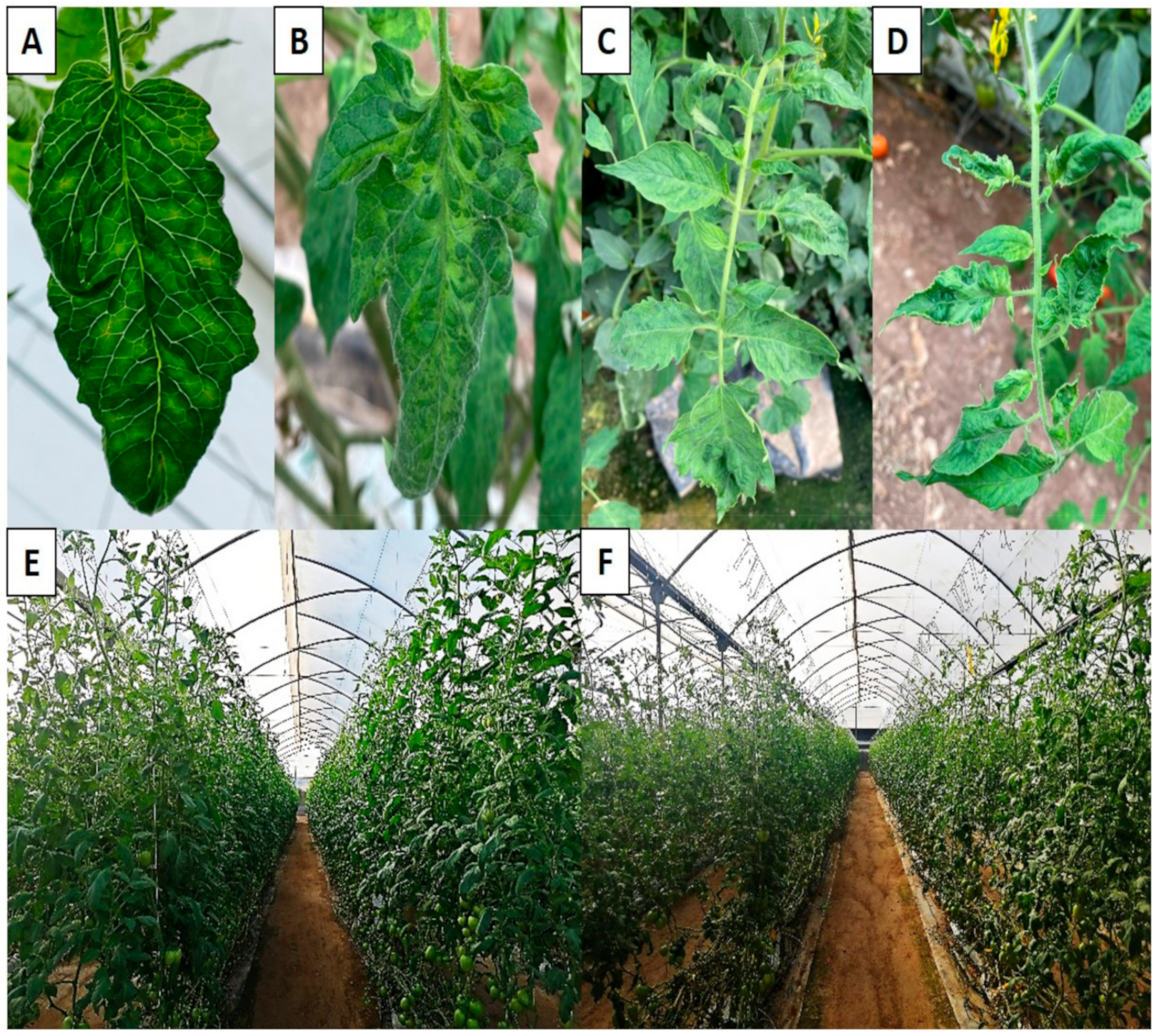
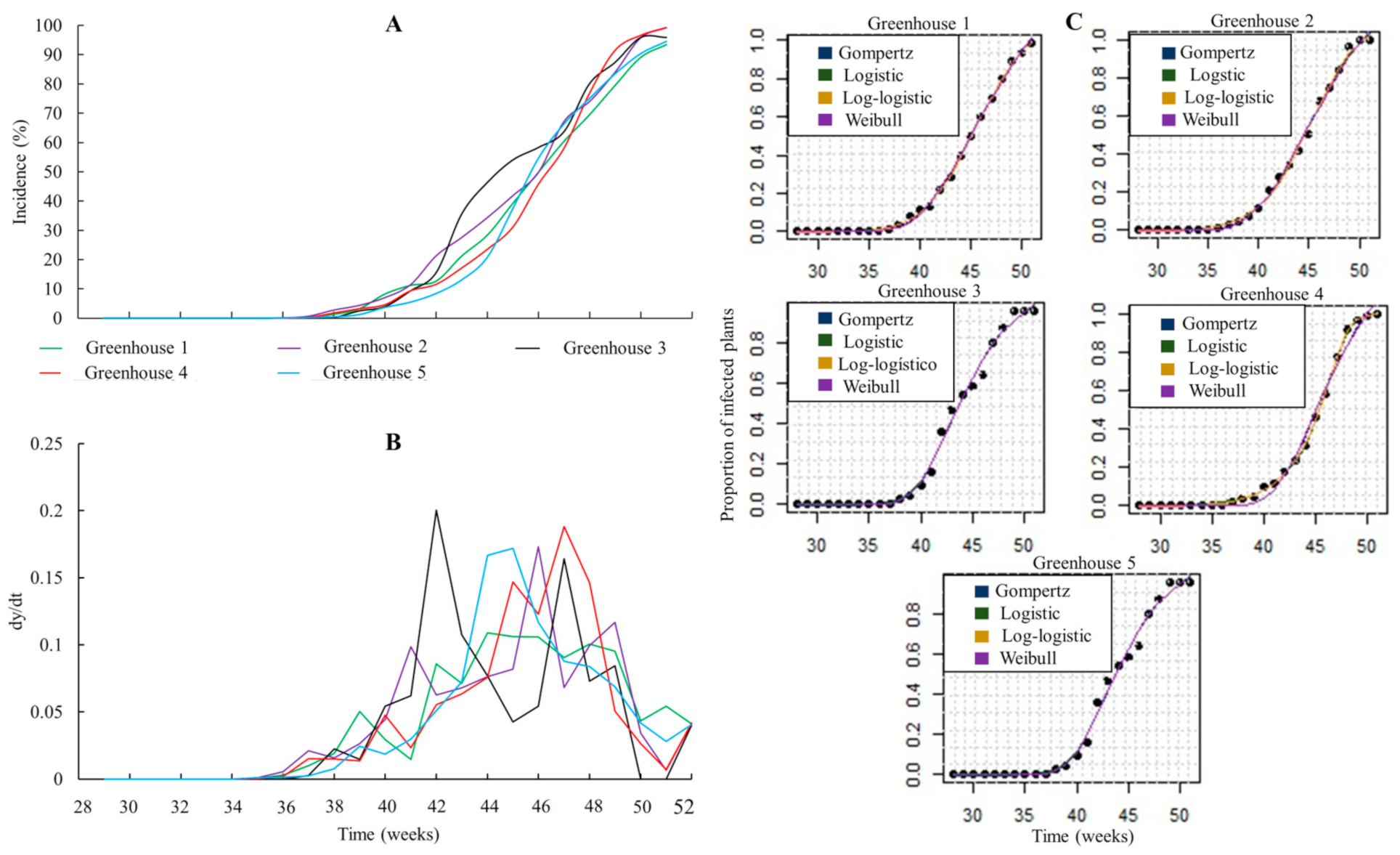
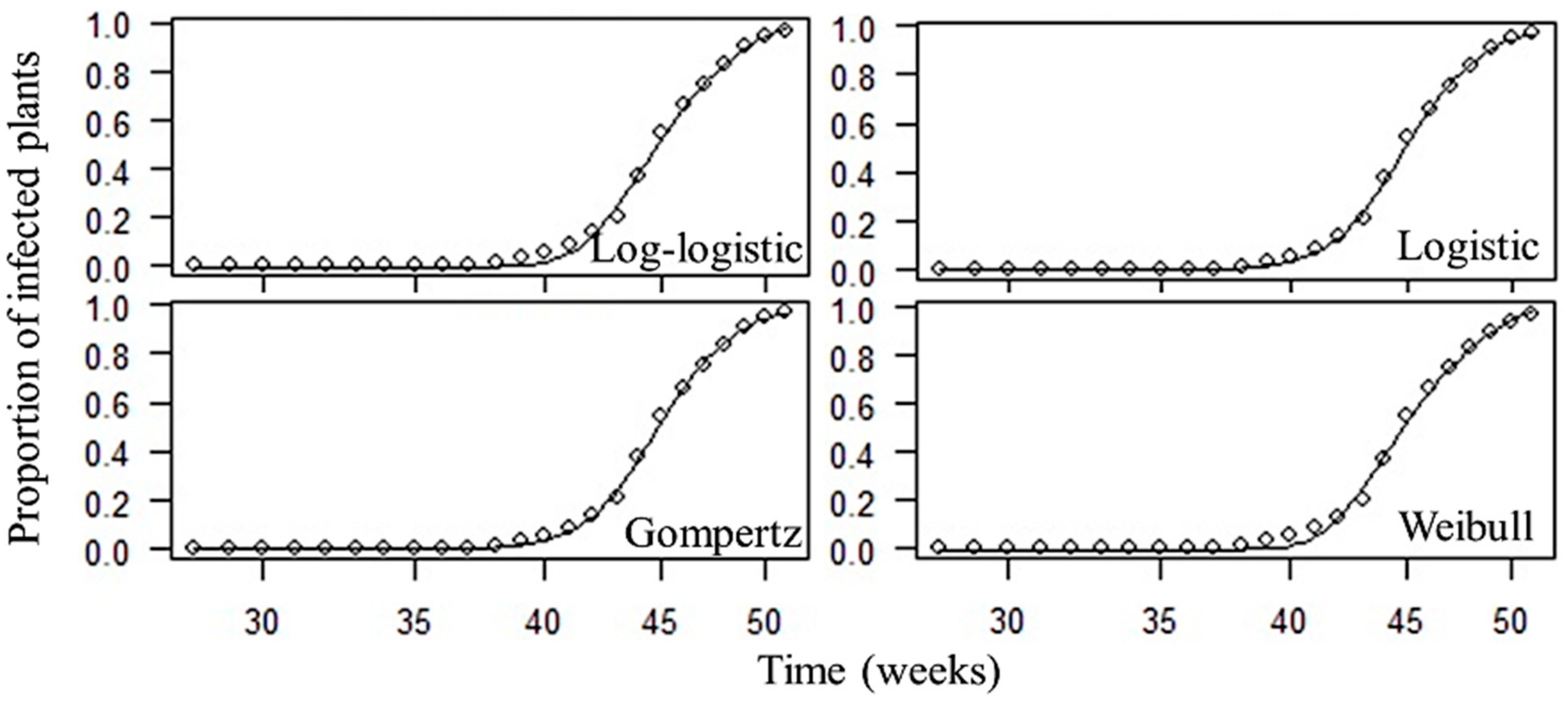
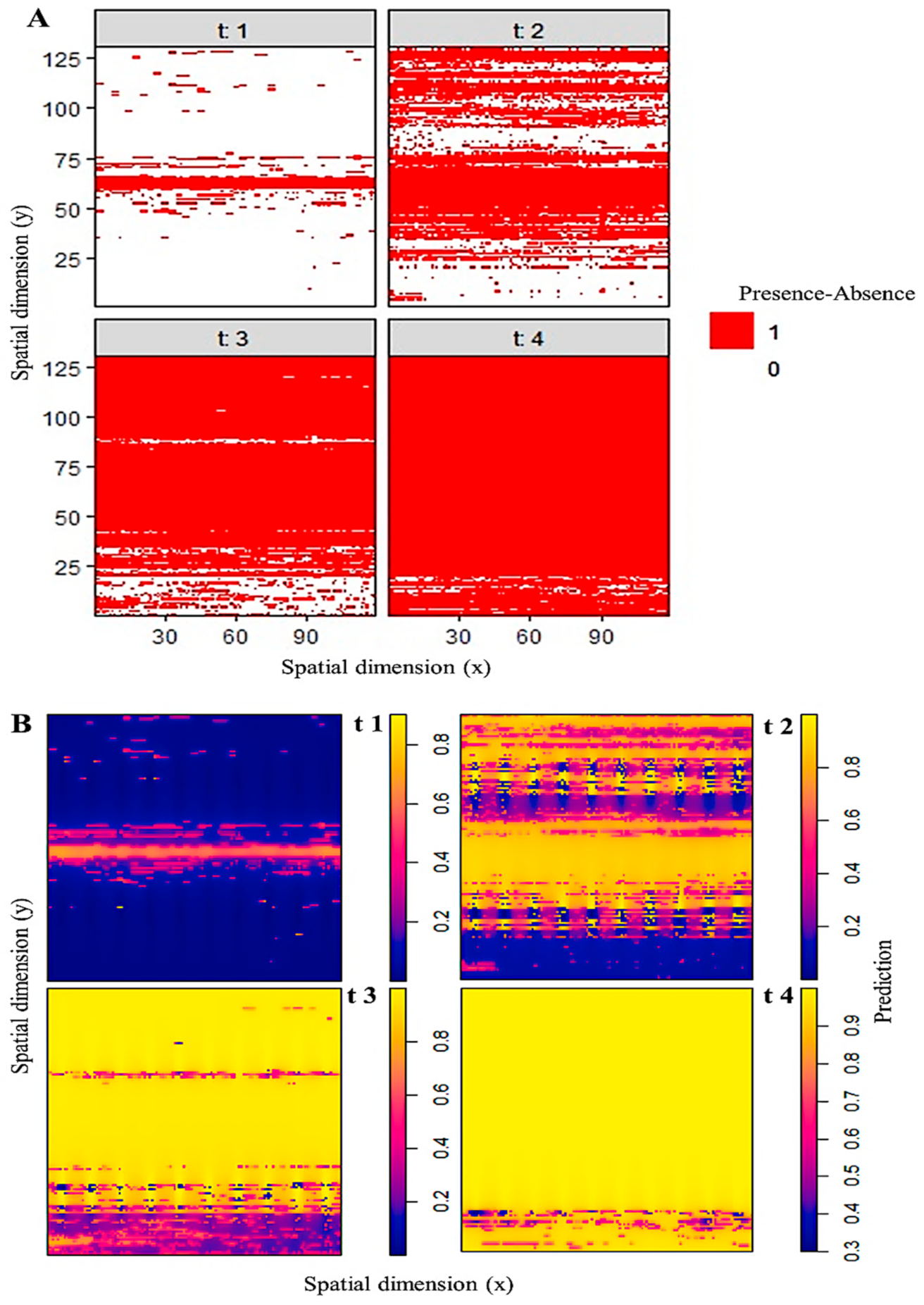
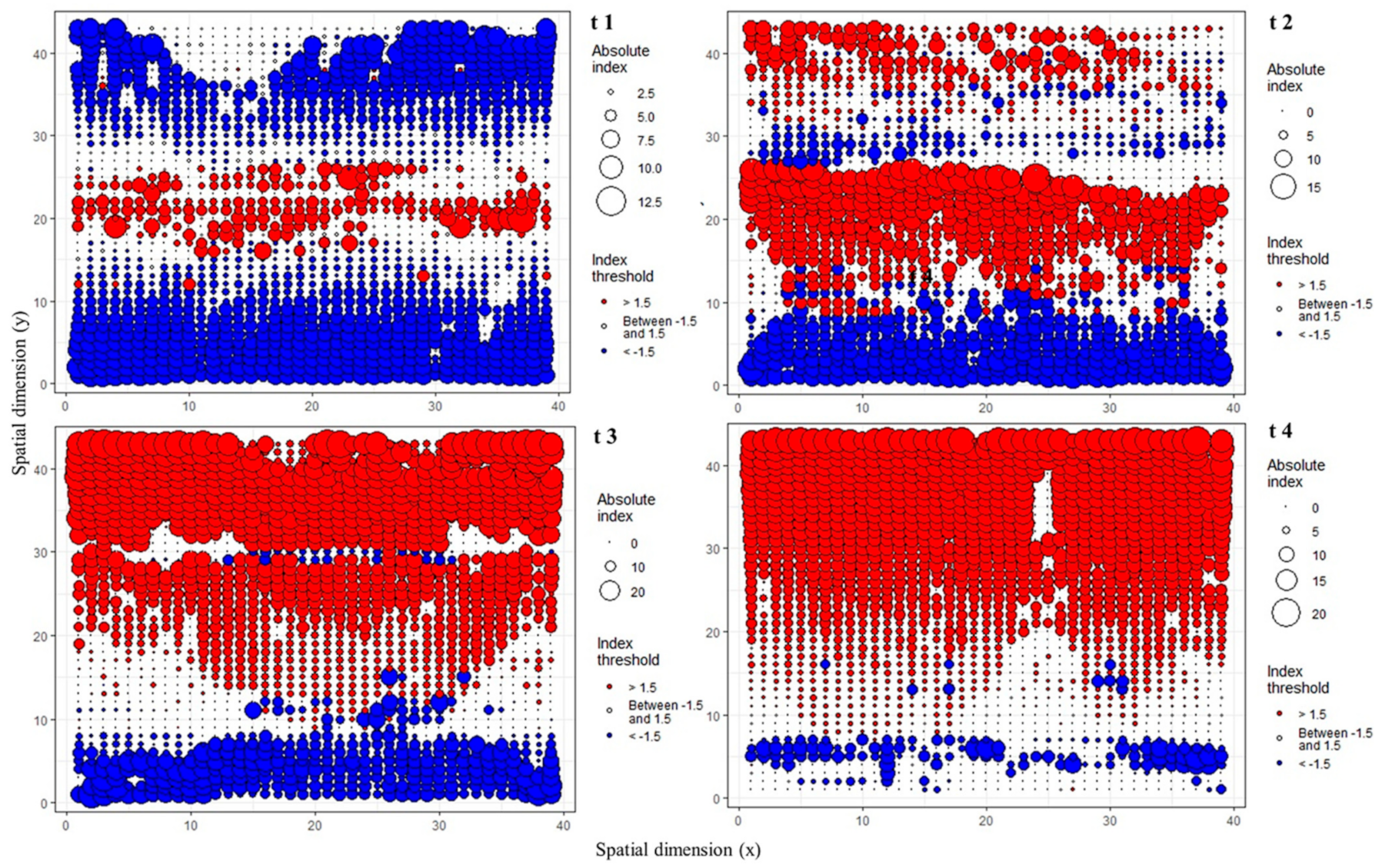
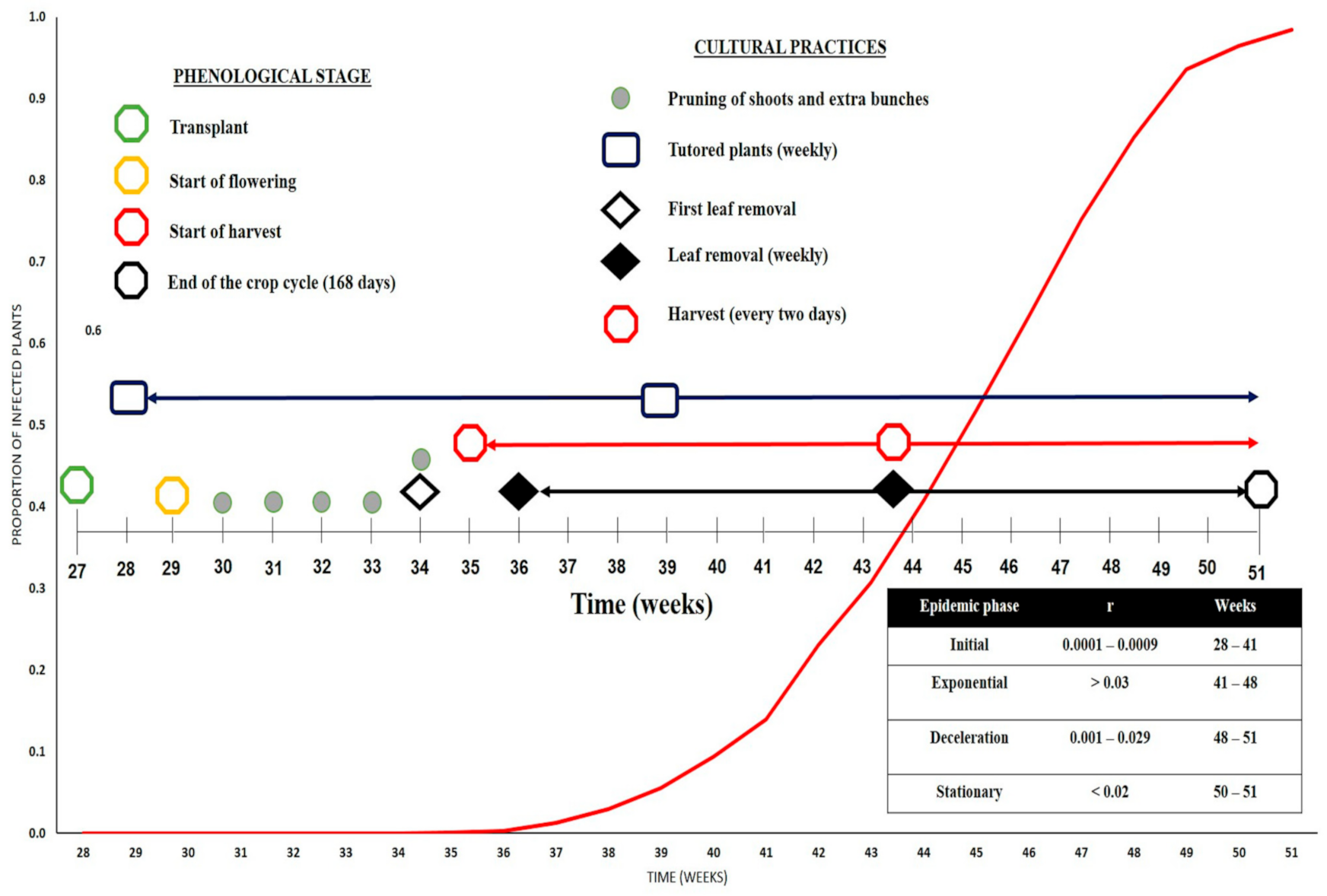
| Greenhouse | Area (ha) | Number of Plants/Greenhouse | Number of Furrows | Transplanting Date |
|---|---|---|---|---|
| 1 | 1.3 | 33,600 | 140 | 15 July 2019 |
| 2 | 1.0 | 26,400 | 110 | 11 July 2019 |
| 3 | 1.1 | 28,800 | 120 | 10 July 2019 |
| 4 | 1.15 | 30,000 | 125 | 13 July 2019 |
| 5 | 1.2 | 31,200 | 130 | 20 July 2019 |
| Model | Differential Form | Linearized Form |
|---|---|---|
| Exponential 1 | y(t) = rE(y) | (ln[y] = ln(y0) + rEt) |
| Gompertz 1 | y(t) = rG y[−ln(y)] | (−ln[−lny] = −ln[–ln(y)] + rGt) |
| Logistic 1 | y(t) = rL y(1 − y) | (ln[y/(1 − y)] = 0 ln[y/(1 − y)] + rLt) |
| Monomolecular 1 | y(t) = rM(1 − y) | (ln[1/(1 − y)] = ln[1/(1 − y)] + rMt). |
| Richard 1 | y(t) = [rR/(η − 1)]y(1 − yη−1) | (ln[/(1/1 − y1−n)] =(ln[/(1/1 − y1−n)] +rRt |
| Log-logistic 2 | y(t) =rL y[1 − y* ln(y)] | (ln[y/(1 − y)] = 0 ln[y/(1 − y)] + t) |
| Weibull 3 | y(t) =c/b (t− a/b)c−1ex[−(t−a/b)c] | (ln[ln/(1/1 − y)] =−cln(b) +cln(t − a) |
| Epidemic Stage | r (Growth Rates) | Development Time (Weeks) |
|---|---|---|
| Initial | 0.0001–0.0009 | 28–41 |
| Rapid or exponential | >0.03 | 41–48 |
| Deceleration | 0.001–0.029 | 48–50 |
| Stationary | ˂0.02 | 50–51 |
| Greenhouse | Model | β0 | β1 | Correlation (r) | Adjusted r2 | Significance | RMSE | AIC |
|---|---|---|---|---|---|---|---|---|
| 1 | Log-logistic | −0.041 | 0.044 | 0.94 | 93.45 | *** | 0.092 | 101.449 |
| Logistic | −0.28 | 0.047 | 0.91 | 83.79 | *** | 0.095 | 110.251 | |
| Gompertz | −0.60 | 0.27 | 0.84 | 70.55 | ** | 0.098 | 115.415 | |
| Weibull | −0.40 | 0.31 | 0.72 | 52.43 | * | 0.102 | 120.857 | |
| Richard | −0.28 | 0.34 | 0.65 | 50.35 | ns | 0.205 | 230.521 | |
| Exponential | −0.45 | 0.15 | 0.62 | 48.32 | ns | 0.325 | 345.145 | |
| Monomolecular | −0.38 | 0.23 | 0.58 | 46.3 | ns | 0.544 | 456.324 | |
| 2 | Log-logistic | −0.03 | 0.045 | 0.93 | 92.19 | *** | 0.098 | 105.709 |
| Logistic | −0.29 | 0.050 | 0.92 | 85.45 | *** | 0.103 | 110.257 | |
| Gompertz | −0.63 | 0.287 | 0.85 | 72.56 | ** | 0.110 | 130.587 | |
| Weibull | −0.42 | 0.331 | 0.73 | 54.41 | * | 0.115 | 160.387 | |
| Richard | −0.12 | 0.45 | 0.62 | 52.4 | ns | 0.258 | 230.456 | |
| Exponential | −0.10 | 0.38 | 0.58 | 46.8 | ns | 0.345 | 240.132 | |
| Monomolecular | −0.23 | 0.18 | 0.51 | 42.52 | ns | 0.500 | 300.265 | |
| 3 | Log-logistic | −0.01 | 0.041 | 0.94 | 90.21 | *** | 0.096 | 108.413 |
| Logistic | −0.29 | 0.051 | 0.92 | 85.77 | *** | 0.100 | 112.321 | |
| Gompertz | −0.64 | 0.29 | 0.85 | 73.39 | ** | 0.105 | 130.521 | |
| Weibull | −0.44 | 0.341 | 0.74 | 55.34 | * | 0.110 | 134.442 | |
| Richard | −0.099 | 0.02 | 0.65 | 58.45 | ns | 0.215 | 200.312 | |
| Exponential | −0.09 | 0.021 | 0.57 | 51.20 | ns | 0.325 | 325.145 | |
| Monomolecular | −0.091 | 0.022 | 0.49 | 47.25 | ns | 0.425 | 455.235 | |
| 4 | Log-logistic | −0.04 | 0.045 | 0.92 | 89.13 | *** | 0.095 | 122.135 |
| Logistic | −0.30 | 0.049 | 0.89 | 79.60 | *** | 0.097 | 129.369 | |
| Gompertz | −0.62 | 0.279 | 0.81 | 66.18 | ** | 0.098 | 135.422 | |
| Weibull | −0.42 | 0.318 | 0.69 | 48.51 | * | 0.100 | 145.258 | |
| Richard | −0.088 | 0.021 | 0.62 | 57.21 | ns | 0.185 | 256.423 | |
| Exponential | −0.065 | 0.054 | 0.61 | 51.42 | ns | 0.155 | 312.654 | |
| Monomolecular | −0.085 | 0.035 | 0.57 | 48.25 | ns | 0.215 | 358.321 | |
| 5 | Log-logistic | −0.02 | 0.043 | 0.91 | 88.88 | *** | 0.088 | 132.403 |
| Logistic | −0.30 | 0.048 | 0.89 | 79.68 | *** | 0.095 | 145.249 | |
| Gompertz | −0.61 | 0.27 | 0.81 | 66.28 | ** | 0.098 | 150.357 | |
| Weibull | −0.41 | 0312 | 0.69 | 48.16 | * | 0.100 | 155.327 | |
| Richard | −0.11 | 0.002 | 0.58 | 53.21 | ns | 0.125 | 300.123 | |
| Exponential | −0.17 | 0.002 | 0.53 | 47.25 | ns | 0.175 | 325.461 | |
| Monomolecular | 0.017 | 0.021 | 0.49 | 42.35 | ns | 0.953 | 395.48 |
| Greenhouse | Epidemic Stage | Moran Index | p Value 1 | Fisher Index | Lloyd Index | Spatial Pattern 2 |
|---|---|---|---|---|---|---|
| 1 | Preinitial 3 | 0.01 | *** | 1.01 | 1.00 | Random |
| Initial | 0.59 | * | 1.21 | 1.1 | Slightly aggregated | |
| Exponential | 0.95 | *** | 2.32 | 1.9 | Highly aggregated | |
| Deceleration | −1.38 | ns | 0.48 | 0.35 | Uniform | |
| Stationary | −5.31 | ns | 0.31 | 0.24 | Uniform | |
| 2 | Preinitial 3 | 0.08 | *** | 1.02 | 1.01 | Random |
| Initial | 0.61 | * | 1.22 | 1.09 | Slightly aggregated | |
| Exponential | 0.96 | *** | 2.45 | 1.99 | Highly aggregated | |
| Deceleration | −3.49 | ns | 0.51 | 0.42 | Uniform | |
| Stationary | −4.99 | ns | 0.30 | 0.27 | Uniform | |
| 3 | Preinitial 3 | 0.04 | *** | 1.00 | 1.01 | Random |
| Initial | 0.42 | * | 1.21 | 1.31 | Slightly aggregated | |
| Exponential | 0.95 | ** | 2.49 | 2.2 | Highly aggregated | |
| Deceleration | −4.32 | ns | 0.49 | 0.39 | Uniform | |
| Stationary | −4.98 | ns | 0.28 | 0.24 | Uniform | |
| 4 | Preinitial 3 | 0.05 | ** | 1.02 | 1.01 | Random |
| Initial | 0.53 | * | 1.41 | 1.21 | Slightly aggregated | |
| Exponential | 0.97 | *** | 2.49 | 2.23 | Highly aggregated | |
| Deceleration | −3.21 | ns | 0.49 | 0.41 | Uniform | |
| Stationary | −5.39 | ns | 0.31 | 0.25 | Uniform | |
| 5 | Preinitial 3 | 0.06 | ** | 1.00 | 1.00 | Random |
| Initial | 0.58 | * | 1.42 | 1.19 | Slightly aggregated | |
| Exponential | 0.96 | *** | 5.00 | 2.13 | Highly aggregated | |
| Deceleration | −2.99 | ns | 0.48 | 0.38 | Uniform | |
| Stationary | −5.12 | ns | 0.32 | 0.21 | Uniform |
Publisher’s Note: MDPI stays neutral with regard to jurisdictional claims in published maps and institutional affiliations. |
© 2021 by the authors. Licensee MDPI, Basel, Switzerland. This article is an open access article distributed under the terms and conditions of the Creative Commons Attribution (CC BY) license (https://creativecommons.org/licenses/by/4.0/).
Share and Cite
González-Concha, L.F.; Ramírez-Gil, J.G.; García-Estrada, R.S.; Rebollar-Alviter, Á.; Tovar-Pedraza, J.M. Spatiotemporal Analyses of Tomato Brown Rugose Fruit Virus in Commercial Tomato Greenhouses. Agronomy 2021, 11, 1268. https://doi.org/10.3390/agronomy11071268
González-Concha LF, Ramírez-Gil JG, García-Estrada RS, Rebollar-Alviter Á, Tovar-Pedraza JM. Spatiotemporal Analyses of Tomato Brown Rugose Fruit Virus in Commercial Tomato Greenhouses. Agronomy. 2021; 11(7):1268. https://doi.org/10.3390/agronomy11071268
Chicago/Turabian StyleGonzález-Concha, Luis Felipe, Joaquín Guillermo Ramírez-Gil, Raymundo Saúl García-Estrada, Ángel Rebollar-Alviter, and Juan Manuel Tovar-Pedraza. 2021. "Spatiotemporal Analyses of Tomato Brown Rugose Fruit Virus in Commercial Tomato Greenhouses" Agronomy 11, no. 7: 1268. https://doi.org/10.3390/agronomy11071268
APA StyleGonzález-Concha, L. F., Ramírez-Gil, J. G., García-Estrada, R. S., Rebollar-Alviter, Á., & Tovar-Pedraza, J. M. (2021). Spatiotemporal Analyses of Tomato Brown Rugose Fruit Virus in Commercial Tomato Greenhouses. Agronomy, 11(7), 1268. https://doi.org/10.3390/agronomy11071268







